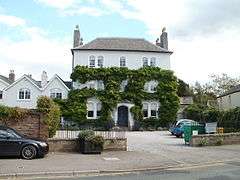Parade House, Monmouth
| Parade House | |
|---|---|
 | |
| Former names | The Harp Inn |
| General information | |
| Address | Monk Street |
| Town or city | Monmouth |
| Country | Wales |
| Coordinates | 51°48′54″N 2°42′46″W / 51.814888°N 2.712651°WCoordinates: 51°48′54″N 2°42′46″W / 51.814888°N 2.712651°W |
| Current tenants | Residential & care home |
| Designations | Grade II listed |
Parade House, is a Grade II listed building in Monk Street Monmouth Wales. The building is 18th-century in origin, has three storeys, gothicised windows, ornate staircase and a hipped roof.
History
The building was formerly an inn known as the Harp Inn in 1801 and consisted of two tenements. It was converted by a local banker in the mid-19th century.[1][2] In 1839/40, Captain Charles Harrison Powell lived here and he had the dubious honour of serving on the Grand Jury when John Frost and two others were sentenced to death for their part in the Chartist Newport Rising.[3]
In 1915 the building and grounds were used as a Red Cross Auxiliary Hospital for convalescent wounded soldiers of World War I. Mr Arnott was a prime benfactor of the hospital. A total of 1,422 patients were treated between 1915 and 1919.[4] The building was listed on 15 August 1974.[5][1]
The building and grounds are currently (2012) used as a residential and care home.
Notes
- 1 2 "PARADE HOUSE, NORTH PARADE". Royal Commission on the National Monuments Record of Wales (NMRW). Retrieved 12 April 2012.
- ↑ Keith Kissack, Monmouth and its Buildings, Logaston Press, 2003, ISBN 1-904396-01-1, page 59
- ↑ Voices for the Vote. Monmouth: Shire Hall. 2011. p. 64. ISBN 978-0-9568745-0-4.
- ↑ Alan Sutton Publishing, Monmouth and the River Wye in Old Photographs, Alan Sutton Publishing, 1989, ISBN 0-86299-481-0, page 15
- ↑ "Listed Buildings in Monmouth, Monmouthshire, Wales". Retrieved 8 April 2012.